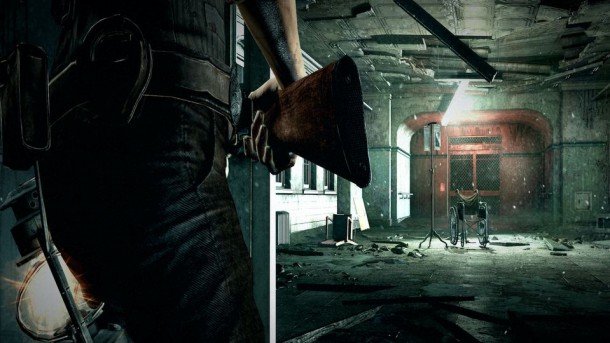The Evil Within hands-on: a bloody spiritual successor to Resident Evil 4

Shooting an enemy won't kill them, even if you blow their head off. You have to burn them. Drop a match on a corpse and it'll be engulfed in flames, twisting in agony as it's reduced to ash. The problem is that—and you'll have to forgive some arbitrary video game logic here—you can only hold five matches at a time. This is one of many restrictions in The Evil Within that places it firmly within the survival horror genre—emphasis on 'survival'—that made director Shinji Mikami's name.
The first thing I notice is how good the lighting is. The game has been built with the latest version of id Tech 5, and it's grimly atmospheric. There's a grainy bleakness to the visuals, with a noise filter making the flickering candlelight and cold glow of the moon look remarkablyt natural. The environment artists seem have taken some cues from Silent Hill, and the world is dark, rusted, and filthy.
There's an impressive amount of detail in the world. At one point I was hiding under a bed and could see a shadow moving in the corner of my eye. Convinced it was an enemy, I froze in panic, waiting for it to leave. It never did, because I soon realised that it was actually a gnarled old tree swaying in the wind outside, casting a shadow on the floor.

Playing it, I'm constantly reminded of Resident Evil 4. The intentionally narrow field of view creates that same feeling of claustrophobia; items glint to signify that they can be picked up; the world is filled with traps, often around blind corners; and it has the same slightly off-centre over-the-shoulder camera. To me it feels like more of a successor to Resident Evil 4 than Resident Evil 5—an evolution of Mikami's masterpiece, rather than an inferior facsimile with some co-op thrown in.
It has plenty of its own ideas, though. While Resident Evil is pretty straightforward horror, The Evil Within—again, perhaps inspired by Silent Hill—is more psychological. There are parts where the world around you shifts and distorts, and some enemies can't be defeated, forcing you to run. It's all about feeling powerless: that moment where an axe-wielding enemy approaches, its mouth contorted into a hideous grin with barbed wire, that you fire, only to hear the hollow click of an empty revolver.
In one scene an exit is blocked by a mass of writhing flesh, and a large group of enemies pour into the room—more than I could ever hope of killing with my limited supply of ammunition. But then I realise that the large chamber I'm in is filled with traps. I can throw a switch and heavy metal spikes fall from the ceiling, or lure enemies towards explosive barrels. Again, I'm reminded of Resident Evil 4 and its brilliant siege scenes. Being aware of your surroundings, and playing creatively, pays off.

Stealth is another solution to your always-limited supplies. You can sneak up on enemies and instantly kill them, but screw up and they'll alert others in the area. Cupboards and beds can be hidden in, and you can toss bottles and other items to distract them. You're never forced into it, though. My tactic of choice was drawing groups of enemies into a bottleneck and firing an explosive crossbow bolt into the throng. But if you don't have the luxury of ammo—and you frequently won't—stealth is important.
Keep up to date with the most important stories and the best deals, as picked by the PC Gamer team.
I experienced a couple of puzzles in my demo, including one where I had to probe the brains of severed heads that seemed mysteriously alive, their eyes rotating and blinking as I stuck a needle into their exposed mind-flesh. Clive Barker-style body horror is the order of the day in The Evil Within, it seems, and anyone squeamish about scalpels, needles, and operations should be wary.
I was never really scared. It was more tense than anything else, with the constant threat of death, and my ever-dwindling ammo, making enemy encounters feel dangerous. I never jumped or felt my heart race. It's more in line with Silent Hill; that constant, gnawing feeling of tension.

My biggest gripe is with hero Sebastian Castellanos, who's far too cool. He rarely seems bothered by the horrors he encounters. As a hideous spider-monster-thing lurches towards him, he says “I better get out of here.” with an incongruously calm nonchalance. Maybe that's the type of character Mikami wants him to be, but I don't think it works particularly well. He should be as scared as me.
But otherwise, I'm impressed. As someone who counts Resident Evil 4 among their all-time favourite games, The Evil Within has an extra layer of significance for me. It's Shinji Mikami's last stint as director, and it's a fitting swan song: a Mikami 'best of' that brings his career full circle.
If it’s set in space, Andy will probably write about it. He loves sci-fi, adventure games, taking screenshots, Twin Peaks, weird sims, Alien: Isolation, and anything with a good story.


